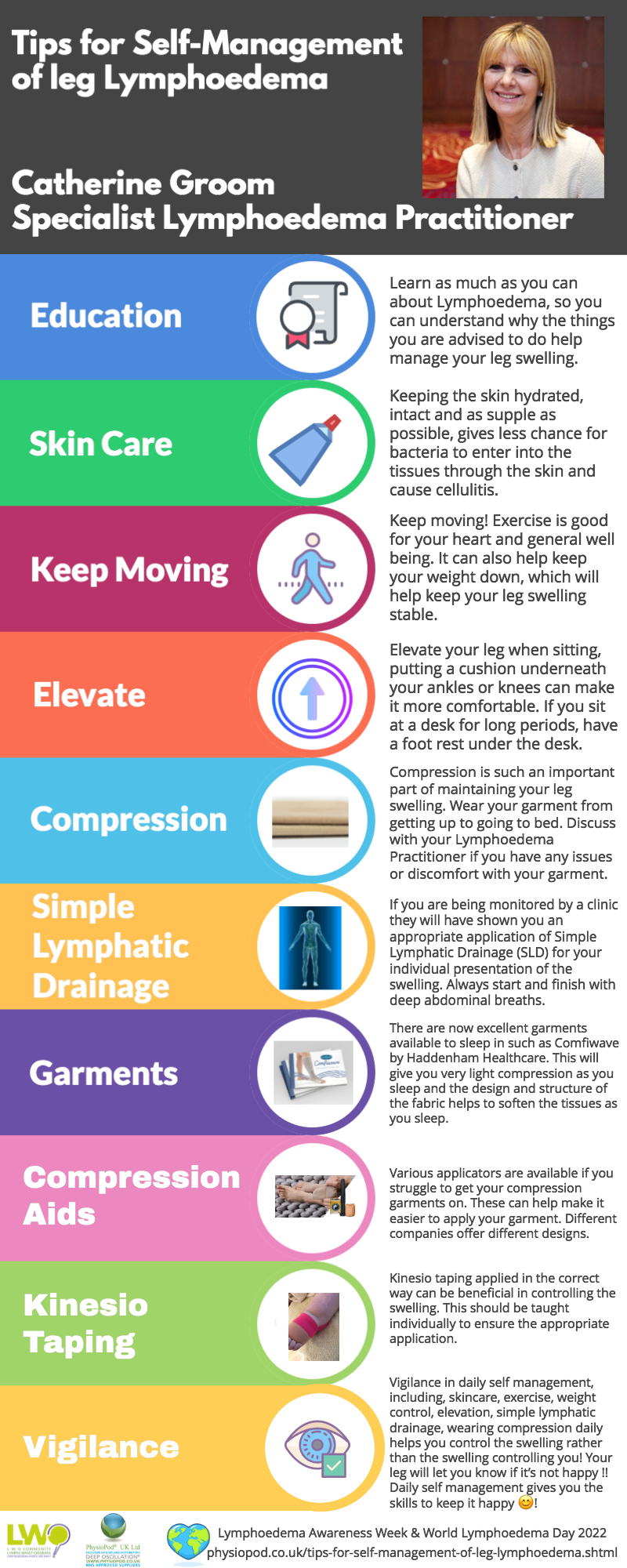Self-Care of Leg Lymphoedema by Catherine Groom - Specialist Lymphoedema Practitioner
- Learn as much as you can about Lymphoedema, so you can understand why the things you are advised to do help manage your leg swelling.
- Skin care is so important in helping reduce the risk of cellulitis. Keeping the skin hydrated, intact and as supple as possible, gives less chance for bacteria to enter into the tissues through the skin and cause cellulitis. If you have been prescribed a cream by your Dr, use it everyday. Your stocking can dry your leg out more, so apply the cream at bedtime, this will give it chance to soak in. Start at the top of the thigh and work in sections down your leg, taking the movement out to the outside (lateral) area of your leg. Your last stroke should be down the leg to make sure any hairs in your leg are laying flat and in the correct position. This reduces the risk of folliculitis which again can trigger cellulitis. If you haven’t been prescribed a cream, use a non-perfumed cream, to avoid any skin reaction to perfumes. Generally take care of your leg and foot to avoid injury. If you do injure your leg, put a good antiseptic on and keep an eye on it. Dry well between your toes to avoid athletes foot and keep your toenails short. If you do suspect cellulitis, ring your GP straight away or go to A&E if you cannot get a GP appointment.
- Keep moving! Exercise is good for your heart and general well being. It can also help keep your weight down, which will help keep your leg swelling stable. Walking, cycling, trampolining, increase muscle pump activity, which increases movement of lymph. Swimming and walking across the shallow end of the swimming pool several times is not only excellent exercise, but also creates hydrostatic pressure to the tissues. Always wear your garment when exercising, except when swimming. Some people do wear a stocking, when swimming, which is ok, but it isn’t necessary because of the hydrostatic pressure on the tissues, Choose an exercise you enjoy and you are more likely to do it ! Remember to keep the calf muscle pump going when you are sitting for long periods. Stretch your foot towards you and then away (dorsiflex), and ‘draw’ a circle with your foot in clockwise and anti-clockwise.
- Elevate your leg when sitting, putting a cushion underneath your ankles or knees can make it more comfortable. If you sit at a desk for long periods, have a foot rest under the desk.
- Compression is such an important part of maintaining your leg swelling. Wear your garment from getting up to going to bed. Discuss with your Lymphoedema Practitioner if you have any issues or discomfort with your garment. You need to be as happy as you can be with what you are wearing. There are so many different options, depending on the presentation of your swelling. Research companies yourself, to see what is available and then discuss it with your Practitioner. If it isn’t suitable they would explain why it wasn’t. The NHS usually provide 2 garments every 6 months. You can purchase more yourself, if you feel you would like more. Open toe can be easier to wear in the summer. It is not suitable for everyone, due to the presentation of their swelling, but it is an option for some.
- If you are being monitored by a clinic they will have shown you an appropriate application of Simple Lymphatic Drainage (SLD) for your individual presentation of the swelling. Always start and finish with deep abdominal breaths. These not only help relax you, but enhance movement within the lymphatics. Try and be vigilant doing 15-20 minutes daily.
- There are now excellent garments available to sleep in such as Comfiwave by Haddenham Healthcare. This will give you very light compression as you sleep and the design and structure of the fabric helps to soften the tissues as you sleep. The range includes a full leg, abdominal and upper leg and thigh design. Discuss with your clinic which would be the most suitable design for you. Not all clinics may be able to provide them, but you can purchase them yourself, as long as your clinic has advised Haddenham which design is the most suitable for your leg.
- Various applicators are available if you struggle to get your compression garments on. These can help make it easier to apply your garment. Different companies offer different designs. Research yourself or discuss with your Practitioner. If you still struggle, compression wraps may be an alternative option for you.
- Kinesio taping applied in the correct way can be beneficial in controlling the swelling. This should be taught individually to ensure the appropriate application.
- Vigilance in daily self management, including, skincare, exercise, weight control, elevation, simple lymphatic drainage, wearing compression daily helps you control the swelling rather than the swelling controlling you! Your leg will let you know if it’s not happy !! Daily self management gives you the skills to keep it happy ????!


